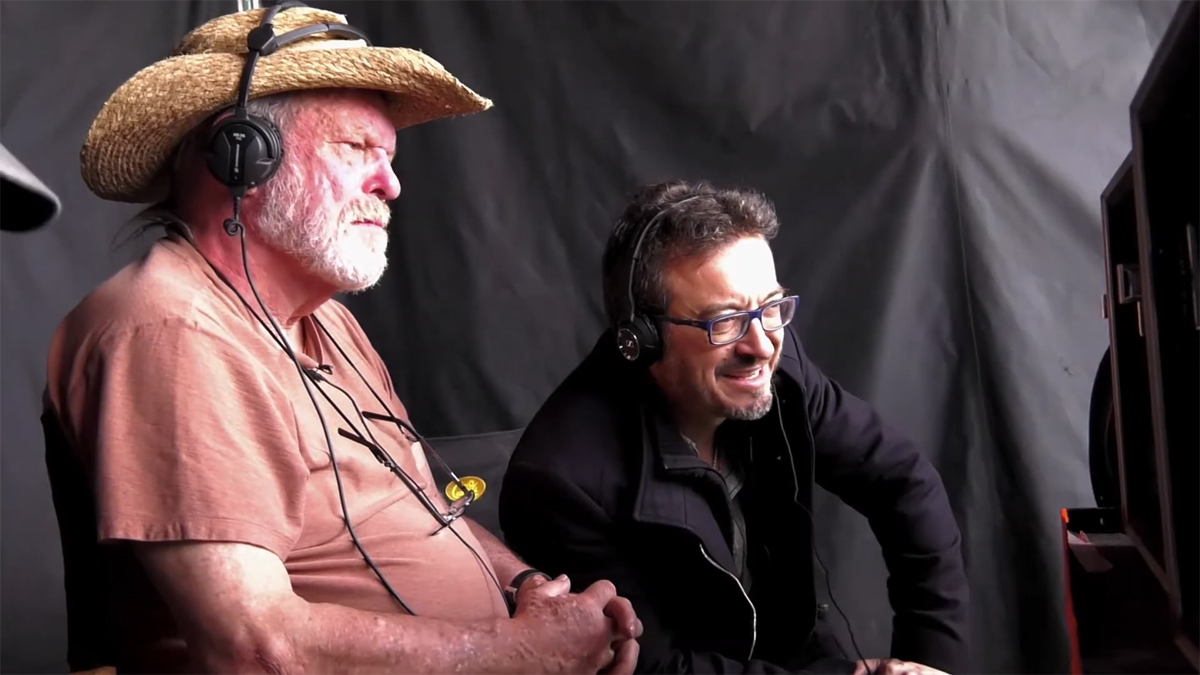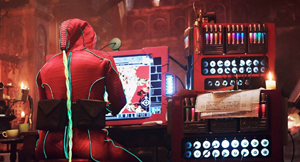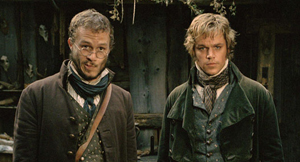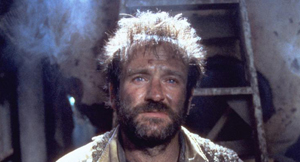Roque Baños, who composed the score for Terry Gilliam’s latest feature film The Man Who Killed Don Quixote, spoke with Phil Stubbs in January 2018 about his work with Gilliam. At this point, Baños’s work on the picture was complete.

Terry Gilliam watches as Baños conducts the orchestra in Bratislava
Philip Stubbs: How and when did you get involved with The Man Who Killed Don Quixote?
Roque Baños: It was early in 2017. I was in Los Angeles. I had a call from the producers. They wanted me to send some of my music to Terry. I did that and then I had a Skype call with him, where we shared thoughts. Before the call, I had read the script. Then a short time after the call, Terry said yes. Then I sent him more of my pre-existing music which he also used after shooting to add to the first cuts.
In the early stages, did Terry provide any musical references?
No, not at all. The first thing he said was that he wanted to experiment. He loves to experiment. So my thoughts turned to what kind of music this movie would need. He knew it had to have a Spanish flavour. He also knew that he didn’t want just orchestral instruments, he wanted something else – he wanted to experiment with ethnic instruments, like the Asian guitars or flutes. We had a great experience using a flute that is made of a horn from a bull.
But it’s not like a classic horn, it’s kind of different. You blow from the thickest part of the horn. It doesn’t sound like a horn, it is more like a recorder, and it gave a baroque sound, but also with an ethnic air. That kind of sound fitted really well in the movie. Also we added different kinds of percussion.
How did you find your starting point for the score?
My starting point always is to find the themes, that’s the main thing with every movie I make the score for. That was also the main concern in Terry’s mind. He really wanted to find what is the main musical theme of the movie. So the first thing that I did was to sit at the piano and try different melodies to find what is the best for the movie.
I came up with a couple of things and I was very lucky. This is the most uncertain part of composing – sometimes it can take a few hours or even a few minutes if you are very lucky. Or it can take days to find a theme. In this case, I came up with a couple of themes in one day. Then I made a piano version, and I sent that to Terry – and he loved it. From there it was just a matter of orchestrating those things for each part of the movie where they were needed. That’s not easy either but you have the themes to work with, having the knowledge that the director likes the theme.

How does the spirit of Quixote come through in the picture?
This Don Quixote is nostalgic, but at the same time it is memorable. He really believes that he’s a hero, that he’s been chosen to do good. So when we see him, we have to feel what he feels – every word that comes from his mouth. Even if it doesn’t make sense, it has to be truthful. We have to feel it that way. You have to feel he’s right.
So the score must help his delusion, to make his delusion more believable to the audience?
When he’s a hero, and when he cares about his beloved Dulcinea, then the music gets very romantic. Because he really loves Dulcinea. Even if she doesn’t exist, and he doesn’t really know who she is, but he loves her. All that delusion, it is really well marked by the music.
Was the orchestra recording straightforward or complicated?
It was really complicated, but not because of the complication of the score, it was because everything used, including the orchestration, was recorded separately. So I had a recording session for only orchestra, then another one with all the ethnic instruments.
There was another one for the choir, and another one for percussion. So the first thing we did was the orchestra. Terry was there, and he was always saying “Wow, this is so wonderful. But where does it go?” He didn’t really recognise where the music would be in the movie, because it was incomplete. I had to keep saying all the time, this is missing the percussion, or some soloist or the choir. But he was always very excited, and he really loved every moment we had in the recording.
Where did the recordings take place?
It was in many places. The orchestra was in Bratislava, and the choir was in Bratislava as well. And then the soloists were recorded in my studio in Madrid. The percussion was recorded in another bigger studio in Madrid.
The separate instruments and the choir… are they for completely separate tracks, or are you layering them?
In the film, we are playing them all together in the same place, and that is what makes the music sound whole. You never notice that there is an instrument that sounds out of the field. When I mix all this, I give everything that I can to get the best mix. But when the sound editors are doing the final mix, and they want to put up or down any section, like the soloist or the orchestra, or the percussion… If they want to play a little bit with that, because the sound of the movie requires some specific fix, they can do that. They have the freedom to play with it and make it fit in another way.

Were there any digital instruments or electronic music added into the mix, or is it all authentic musical instruments?
There is some sound design. The best way to explain this is with an example. I used wind for some things where there is a desert. The characters walk in a desert, so I took wind from the street. Then I found a tone in that wind, and I play with that sound to get out that tone. Then I added it in the music to achieve a warmer sound that I could use with the rest of the instruments – it’s like getting a musical note from what you see in the picture. It is something that I really love and I use it in my scores, but I always try to incorporate into the music something that is in the picture… so it’s not all orchestra.
Are there any other examples that you have sampled sound in the score?
Yes, there is another one that I also sampled. There was a scene where Quixote believes he is flying to the moon. There are many people watching in a big party. All the guests are watching him riding a wooden horse, and he believes he is flying to the moon. What I did in that scene, I sampled whispers from the crowd. I sampled that and used it, and mixed with a choir. So it’s like a weird sound that is contemporary music that creates this atmosphere that is confusing and crazy.
And there are a couple of cues where I used some more modern loops, but just a little bit. It’s not much.
Which scene gave the most trouble, the most problems?
It was that one, we had to mix the whispers with horns, with orchestra, choir and percussion. The people you see in the picture, they play instruments. I had to make everything to fit with what is in the screen and it was really complicated.
Is there one scene you are most proud of, where you think the score and the pictures go so well together?
I am very proud of that scene but it’s not my favourite. I think there are many magical moments in the movie that they are really touching and I remember one of them towards the end of the movie – where Quixote says to Toby. He says it is over, it is all over, and then Toby gets very angry with him. Toby then runs away to try to find Angelica who is really in danger. So that moment, all that is covered with music. That moment when Quixote says it’s over, all the way through until Toby finds Angelica and she’s not Angelica, she’s the boss’s wife.
All that scene I really love how the music deals with that very dramatic moment. All that work of Toby trying to find Angelica through the huge costume party where everybody is dancing, yet the music plays in a totally opposite way, really dramatic. That’s very impacting.
What musical influences did you use for that scene, what genres did you draw on?
This is very hard to answer because I’m not sure; I just do what I feel. If I may say, it could have a flavour of the Spanish classical maybe Manuel de Falla, the Spanish composer from the 19th century. It’s hard – I just do what my heart feels.
The scene at the farm. For a long time it was not going to be in the film, but it’s now back in. When did you find out that it was going back in the film?
We were actually doing the orchestral recording in Bratislava. Terry came out one day with the idea of putting that scene back in the movie. It was in at the beginning actually. Then it wasn’t, and when we were recording, he said, I’m gonna put this back in the movie. Then we had to do some more music for that sequence.
Were you able to able to record more score in Bratislava?
We didn’t have time to do the whole thing, but we did enough. Terry and I had talked about what could be in there, then I recorded some more stuff and I think we came out pretty well with a score for that one.
Which scene most resonates with you?
Yes, there is one scene… near the end when Toby looks up to the sky, and there is thunder and lightning. I was impressed how it was shot, and the face of Adam, it is amazing.
What have you found most rewarding about working on this picture?
To me, the best part of all this was meeting with Terry and sharing my creativity with his. That was amazing. I remember every day we met, making the score, we had such a great time inventing and imagining mixing things together, like this instrument with the others. I really enjoy working closely with Terry. It’s amazing. He’s really enthusiastic, and I feel that way too. I feel really, really involved with what I’m doing, always, and finding someone like him, it’s great because we were on the same page all the time. His ideas and my ideas – they really meld well together. We enjoyed that a lot.
And to what extent does Terry resemble Cervantes’s character Don Quixote?
It’s inspired him for years. Terry is a real believer in a cause. I really think he is the real Don Quixote. He loves this project as Don Quixote loves Dulcinea. He took care of it all the time until he actually made it. Terry has been fighting against everything to get this movie done. I feel really lucky, very proud. This is an amazing experience and opportunity – to be with him in a movie like this.

















